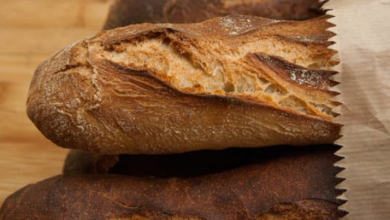Baguette Vs. Ciabatta: Which One Will Win the Battle?

What To Know
- For those seeking a classic French bread with a crispy crust and delicate flavor, the baguette is an excellent choice.
- If a more rustic bread with a robust flavor and airy texture is desired, ciabatta is the way to go.
- Store baguette and ciabatta in a cool, dry place, wrapped tightly in plastic or a bread bag.
In the realm of bread, two titans stand tall: the baguette and the ciabatta. Both hailing from different corners of the world, these loaves have captivated taste buds for centuries. With their distinct flavors, textures, and appearances, the baguette and ciabatta offer unique culinary experiences that set them apart from the rest. In this epic showdown, we’ll delve into the depths of each bread, exploring their origins, characteristics, and the culinary magic they bring to the table.
History and Origins
The baguette, a symbol of French culinary prowess, traces its roots back to the 19th century. Its elongated shape and crispy crust have made it an indispensable part of French culture, often gracing breakfast tables, lunch bags, and dinner plates.
Ciabatta, on the other hand, emerged from the heart of Italy in the late 20th century. This rustic bread, characterized by its airy texture and large holes, quickly gained popularity beyond its borders, becoming a staple in bakeries and restaurants worldwide.
Appearance and Texture
At first glance, the baguette and ciabatta present strikingly different appearances. The baguette, with its long, slender form, exudes an air of elegance and sophistication. Its golden-brown crust, adorned with diagonal slashes, hints at the crispy delight within.
Ciabatta, in contrast, embraces a more rustic charm. Its wide, flat shape and irregular surface, marked by large holes, evoke a sense of authenticity and artisanal craftsmanship. The crust, while not as crispy as the baguette’s, offers a satisfying crunch that complements the soft, airy interior.
Flavor and Aroma
The baguette’s flavor profile is characterized by a delicate balance of wheatiness and a subtle hint of sweetness. Its crust, with its caramelized exterior, adds a layer of complexity, contributing to an overall harmonious taste experience.
Ciabatta, on the other hand, boasts a more robust flavor profile. Its wheatiness is more pronounced, with a slight tanginess that adds depth and character. The large holes, which allow for more surface area, contribute to a more intense flavor absorption, making each bite a delightful explosion of taste.
Culinary Versatility
The baguette’s versatility extends far beyond its role as a sandwich bread. Its crispy crust and airy interior make it an ideal accompaniment to soups, stews, and salads. It also shines as a base for bruschetta, crostini, and other appetizers.
Ciabatta’s versatility is equally impressive. Its sturdy texture and robust flavor make it a perfect choice for sandwiches, paninis, and burgers. Its large holes provide ample space for fillings, while its crusty exterior adds a satisfying crunch. Ciabatta also excels in bread salads, bread puddings, and various Italian dishes.
Nutritional Value
Both baguette and ciabatta offer nutritional benefits, although they differ in certain aspects. The baguette provides a good source of carbohydrates, fiber, and some essential vitamins and minerals. Ciabatta, on the other hand, is generally lower in calories and carbohydrates than the baguette, making it a slightly healthier option. It also contains a good amount of fiber, protein, and vitamins.
Which One to Choose?
The choice between baguette and ciabatta ultimately depends on personal preference and the intended use. For those seeking a classic French bread with a crispy crust and delicate flavor, the baguette is an excellent choice. If a more rustic bread with a robust flavor and airy texture is desired, ciabatta is the way to go.
The Ultimate Showdown: A Culinary Journey
To truly appreciate the nuances of baguette and ciabatta, embark on a culinary journey that explores their diverse applications. From classic French sandwiches to hearty Italian paninis, from bruschetta topped with fresh tomatoes and basil to bread salads bursting with Mediterranean flavors, each dish showcases the unique qualities of these remarkable breads.
Questions We Hear a Lot
1. What is the best way to store baguette and ciabatta?
- Store baguette and ciabatta in a cool, dry place, wrapped tightly in plastic or a bread bag. They can also be stored in the refrigerator for up to 3 days or frozen for up to 2 months.
2. How can I keep baguette and ciabatta fresh for longer?
- To maintain the freshness of baguette and ciabatta, store them in an airtight container at room temperature. Alternatively, you can slice the bread and freeze it in resealable bags for longer storage.
3. What are some creative ways to use baguette and ciabatta?
- Baguette can be used to make croutons, bread crumbs, and French toast. Ciabatta can be used to make garlic bread, bruschetta, and panzanella salad. Both breads can be used to make sandwiches, wraps, and bread bowls.
4. Can baguette and ciabatta be used interchangeably in recipes?
- While baguette and ciabatta have similar applications, they may not always be interchangeable in recipes due to their different textures and flavors. Baguette is best suited for recipes requiring a crispy crust, while ciabatta is ideal for dishes where a soft, airy texture is desired.
5. Which bread is healthier, baguette or ciabatta?
- Ciabatta is generally considered to be the healthier option compared to baguette. It is lower in calories and carbohydrates and higher in fiber and protein. However, the nutritional value of both breads can vary depending on the ingredients used and the preparation method.





